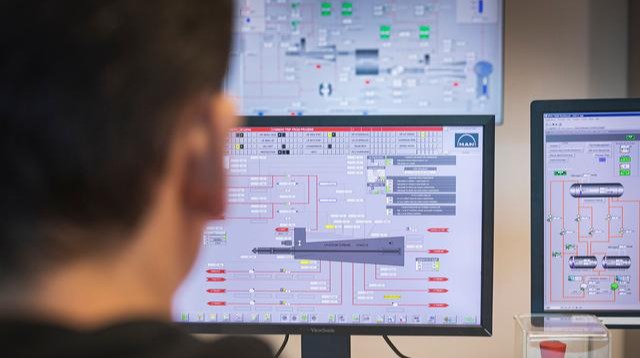How to optimize your maintenance strategy with engine digitalization?
Industry 4.0 is the digital transformation of the manufacturing sector, using smart technologies such as loT, cloud computing, analytics, AI and machine learning. It enhances productivity, flexibility and agility, and enables real-time decision making, as well as improved quality, efficiency and responsiveness.
The marine and power sectors are also embracing this transformation. By equipping your engine with sensors and software that gather and process performance data, you can adopt a smarter approach to maintenance, with higher levels of efficiency, sustainability, safety, security, and availability.
At MAN PrimeServ, we are committed to supporting your diesel engine digital transformation journey, wherever you are in the process. We offer innovative solutions that are tailored to your needs and keep pace with the evolving technology.

Digital engine data leads to actionable insights
Digitalization is transforming the performance and efficiency of engines and gensets. By capturing and analyzing data from the start, they can provide valuable insights for operation's optimization and maintenance.
This is not only true for newer equipment, but also for older ones that can be upgraded with digital solutions. Digital upgrades can unlock the full potential of older engines and gensets, enhancing their reliability, performance, and lifespan.
Whatever generation of hardware you are running, and whichever maintenance strategy is right for your business, we can support you with digitalization solutions that optimize your processes and support your journey towards Industry 4.0.
Engine Data
Engine information
Actionable insights

What are the different types of maintenance strategies? Academic definitions
Explore the maintenance strategies by clicking the tabs below.
Corrective maintenance

Run to Failure
Maintenance is carried out only if and when anomalies are detected or in case or failure. This approach is based on the assumption that maintenance and downtime costs will always be lower than the costs of other maintenance strategies.
Key benefits
- Cost-effective approach where data-supported actionable insights are not a priority
- Works for low-value assets but not high-value, mission-critical assets such as a main engine
- Any data and information would only be used reactively, not proactively
Preventative maintenance

Follow maintenance schedules
This is the most common engine maintenance strategy. Here, maintenance is carried out at pre-determined intervals (e.g.,hours of running time) as defined by their own designs, risk analyses, mean-time-between-failure studies, and experience. Asset owners must typically follow these to achieve compliance with classification societies and insurers.
Key benefits
- More cost-effective than reactive maintenance approaches
- More predictable maintenance scheduling with less unplanned downtime
- Cost-effective if the maintenance costs are lower than the costs induced by an overhaul after a major failure of the equipment (eg.g., replacement of an engine crankshaft) and its consequences (e.g.,extended downtime, production stops, and related impact on the entire vessel and/or enterprise)
- Suitable for high-value and/or critical assets
Condition-based maintenance

Use sensor data and analytics to fix issues now
Maintenance is carried out when pre-defined conditions or thresholds are met. Condition-based maintenance is typically a supplement to planned/ preventive maintenance regimes.
Key benefits
- Sensors provide data on critical parameters
- Maintenance needs are signalled based on actual conditions
- Maintenance and condition monitoring software analyze data; analysis can occur onsite or remotely
- Can potentially reduce planned maintenance downtime and related costs (maintenance is carried out only when warranted by actual conditions)
- A good supplement to planned maintenance
Predictive maintenance

Use sensor data, analytics, and AI to foresee issues
Relevant engine components are constinuously monitored, and data is transmitted for ongoing analysis. Using this data alongside engine-specific, precise wearing rate information, AI-powered algorithms predict exactly when maintenance is required, and only necessary maintenance is performed. In its pure form, this is the 'holy grail' of maintenance strategies. Pragmatically, predictive maintenance is combined with other maintenance regimes.
Key benefits
- Sensors provide data on critical parameters
- Maintenance is performed only as needed
- Maintenance and condition monitoring software analyze data; AI and machine learning enable ongoing optimization of algorithms
- Remote analysis support provides actionable insights regarding optimal time to perform maintenance
- Fewer unplanned downtime events through improved maintenance prioritization
With you at every step of your digitalization journey
We are already supporting multiple customers worldwide with digital solutions that allow them to personalize their digitalization journey and "keep" the asset at the state-of-the-art of a smarter maintenance for their engines, could be preventative, condition-based and more and more predictive.
Our engineering and R&D teams are also developing cutting-edge technologies that will soon enable condition-based and predictive maintenance solutions. This means that wherever you are in your digital transition journey, MAN PrimeServ is by your side with expertise and solutions ready now and in the future as the technology that supports them continues to evolve.
If you need to achieve a specific outcome from your engine maintenance solution, click one of the icons below.
Contact our experts
We're standing by to help
Explore more topics
MAN Energy Solutions is now Everllence.
We have adopted a new brand name and moved to a new domain: www.everllence.com. This page will also be relocated there shortly. We are working on shifting all pages to www.everllence.com.




